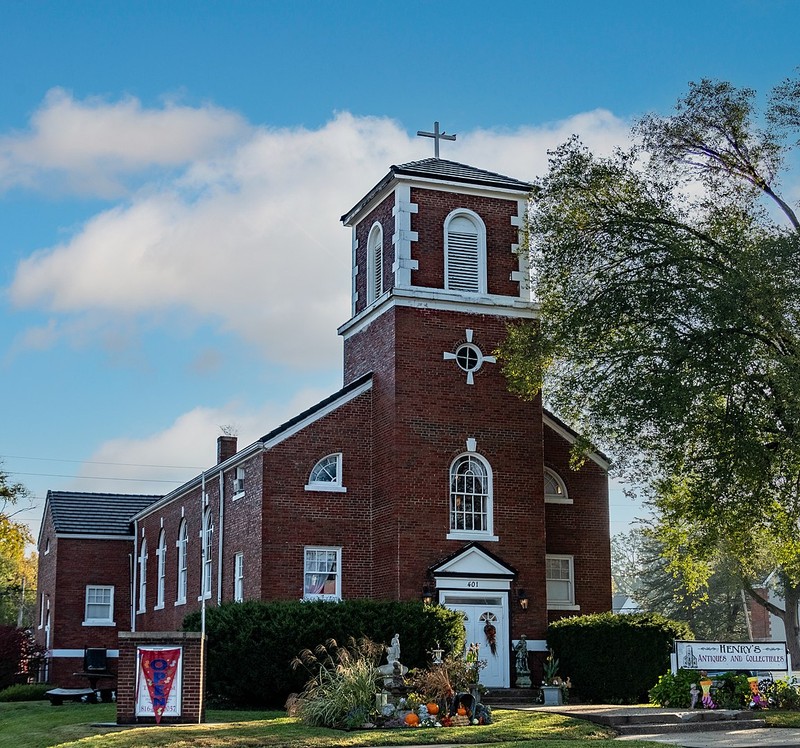Historic Lee's Summit Christian Church Building
Introduction
Text-to-speech Audio
Built in 1949, this building represents the trends in Protestant church architecture and was originally home to Lee's Summit Christian Church before the congregation moved to a new location. The Colonial Revival style emerged after the war as a popular design in association with the trend towards simplified styles. The church itself dates back to the 1870s when a dozen people founded the non-denominational institution. The congregation met at this building near downtown Lee's Summit until 1985 when they moved to the outer reaches of the city, a trend that has been seen in many other churches as members move further from city centers. The building is listed on the National Register of Historic Places and was home to an antique shop at the time of this article's publication in 2021.
Images
Lee's Summit Christian Church Building

Backstory and Context
Text-to-speech Audio
Completed in 1949, the Colonial Revival style Lee's Summit Christian Church Building is associated with the simplification of traditional church designs in the period following World War II -- an era noted for a dramatic change in U.S. church architecture and design. Lee's Summit Christian Church emerged as a non-denominational entity during the 1870s and remained in Lee's Summit until 1985. The church building arose prior to the rapid suburbanization of Lee's Summit in the 1950s; the congregation moved to the suburbs in 1985.
Twelve founders established the Christian Church of Lee's Summit, Missouri (Disciples of Christ), in 1870. The congregation adhered to the principles developed during the Christian Church Restoration Movement, which emerged in the U.S. during the Second Great Awakening of the early nineteenth century. The movement aimed to restore the "true" first-century church, as described in the Book of Acts, found in the New Testament. As a non-denominational church, they referred to themselves simply as Christians. Initially, the small group held services in Dryden's Hall. By 1873, with a membership of sixty-five, they erected a small brick church building at Fourth and Douglas Streets. In the late 1890s, the congregation demolished this building and completed (in 1898) a new wood-frame church suitable for its expanding membership, which had reached 150. However, a fire destroyed the fifty-year-old church building on January 13, 1948. The congregation, which by then had grown to 260, held worship services at a high school until the members could build a new church, which today stands as the historic Lee's Summit Christian Church Building.
The Lee's Summit Christian Church Building design reflects the early post-World War II trends as the American Colonial Revival style became the most popular expression of the conservative Protestant movement after the war. The style had also been popular during the Revolutionary Era and after the nation celebrated its centennial. Like many other houses of worship erected in the early postwar period, the church building's Colonial Revival style also drew inspiration from the streetscape as well as conventional church architectural designs. In short, its design reflects an era after the war that did not initially embrace modernism. Instead, akin to other religious congregations during that period, the members of Lee's Summit Christian Church expected their church to "look like a church." Designed by prominent Kansas City architect Phillip T. Drotts, the post-World War II Colonial Revival style church building reflects the continuation into the mid-century of the prevalent revival styles in the city and nation. Its gable-front bell tower, symmetrical fenestration, modest decor, and arched windows indicate the favor of the traditional church design immediately after the end of the war before a tremendous shift in religious architecture to Modern Movement styles a decade later.
In the 1950s, the congregation's continued growth pushed the church to purchase the adjacent property at 407 S. Douglas. One of the two houses on the property served as classrooms, while the other was demolished in the 1970s and replaced with a parking lot. By the 1950s, the return of troops, "white flight," and overall suburban sprawl led to an increase in church construction in suburban communities throughout the U.S. By the 1980s, an abundance of churches, including Lee's Summit Christian Church, elected to buy larger suburban properties (or places removed from downtown) that supported both worship and educational buildings. In 1985, the congregation moved to a new location and the building has been home to an antique store in recent years.
Sources
Lee's Summit Christian Church. Accessed December 14, 2021. https://lschristian.com/.
Schwenk, Sally Fullerton and Amanda K. Loughlin "Lee's Summit Christian Church Building." National Register of Historic Places. mostateparks.com. 2011. https://mostateparks.com/sites/mostateparks/files/Lee%27s%20Summit%20Christian%20Church%20Bldg.pdf.
By Thetompugh - Own work, CC BY-SA 4.0, https://commons.wikimedia.org/w/index.php?curid=95375837
